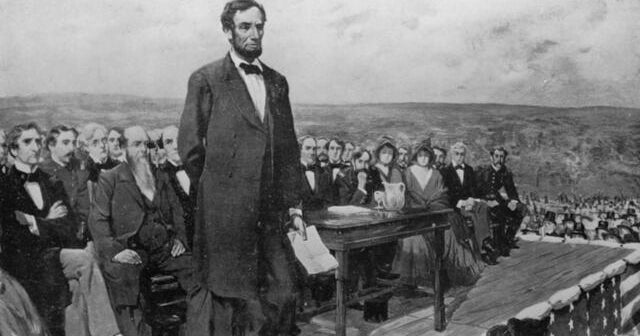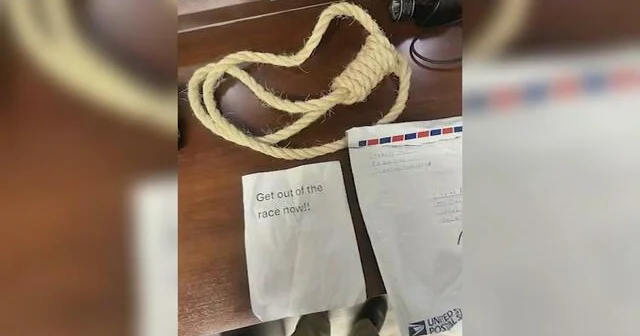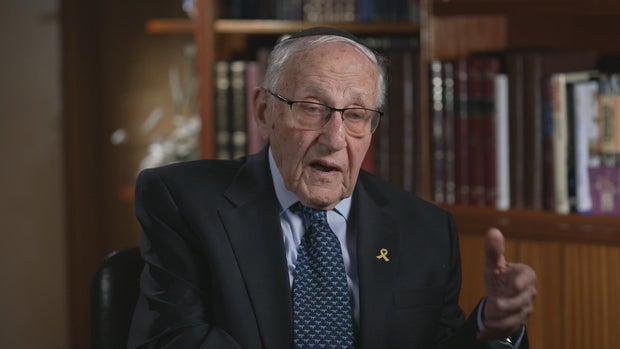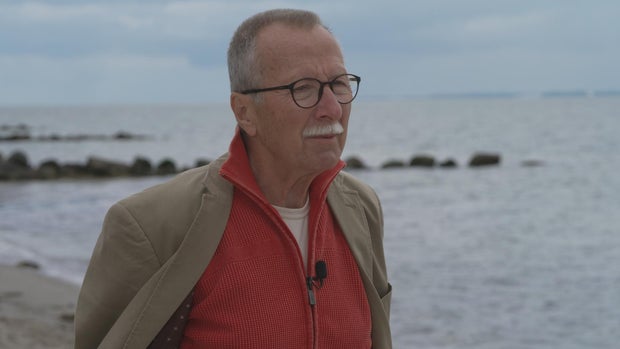CBS News
Thousands of migrants leave southern Mexico for the U.S. weeks ahead of presidential election

A group of about 2,000 migrants left Mexico’s southern border Sunday hoping to reach the country’s north and ultimately the United States. The development comes weeks before the U.S. presidential election, in which immigration has been a key issue.
Some migrants, like Venezuelan Joel Zambrano, believe a new administration in the U.S. could put an end to asylum appointments through an online system called CBP One.
“That is what makes us fearful. They say this could change because they could both close the CBP One appointment and all the services that are helping migrants,” he said.
Both the lack of jobs in Mexico’s south due to a new wave of incoming foreigners and a delay in asylum appointments in the U.S. have motivated more groups of migrants to leave the region in the past month.
“The situation in my country is very bad, the president doesn’t do anything for us. We spent a week by the border, but getting documents takes time,” said Honduran Roberto Domínguez, 48. “The documents we get are only for us to be in Tapachula and we cannot leave the city.”
The group leaving Sunday was the third and the largest since the beginning of the administration of new Mexican President Claudia Sheinbaum, who so far has made no changes in immigration policies established by her predecessor, Andrés Manuel López Obrador.
Groups of 800 and 600 migrants left the region earlier in October.
Activist Luis García Villagrán estimates about 40,000 migrants are currently stranded in southern Mexico.
Last month, the Biden administration announced new regulations to cement the partial asylum ban it enacted in June at the southern U.S. border, in a move that will likely extend the strict immigration policy indefinitely, CBS News’ Camilo Montoya-Galvez reported. Administration officials have cited the asylum restrictions as the primary reason for the drop in illegal crossings by migrants at the U.S.-Mexico border this year.
Many migrants who came to the U.S. through a sponsorship program designed to reduce illegal border crossings in recent years are set to lose their legal statuses by the end of October, since the Biden administration decided not to extend their coverage.
Under the program, about 214,000 Haitians, 117,000 Venezuelans, 111,000 Cubans and 96,000 Nicaraguans have so far come to the U.S. to live and work legally for two years, per an immigration law known as parole. The first group set to begin losing their parole status this month are Venezuelans, who started arriving in the U.S. through the program in October 2022.
CBS News
Holocaust survivors who witnessed the Cap Arcona bombing share their stories | 60 Minutes

During the Holocaust, Manfred Goldberg survived confinement in the Riga, Latvia ghetto and four concentration camps before he witnessed a bombing in Germany that took the lives of thousands of prisoners.
On May 3, 1945, just days before the end of World War II in Europe, British Royal Air Force planes mistakenly attacked the Cap Arcona ocean liner in Lübeck Bay in the Baltic Sea. The ship was crammed with thousands of concentration camp prisoners.
As the planes struck, Goldberg was at a nearby German naval base, lined up under SS guard with other prisoners.
“And it is while we stood there that we witnessed bombers and fighter planes coming along,” Goldberg said.
He remembers seeing the planes drop ordnance and hearing detonations.
“There were some pretty powerful explosions, and there were quite a few,” Goldberg said.
Before the war
Before World War II, the Cap Arcona was a German cruise ship for the well-to-do. For more than a decade after its 1927 launch, the ocean liner transported well-heeled passengers from Europe to South America in just two weeks. The ship had many luxuries, including a tennis court, a heated swimming pool and a restaurant with an ocean view, historian Bill Niven said.
The cruise ship traversed the Atlantic dozens of times. On one of its last trips before the war, the ocean liner carried some German Jewish passengers who had bought tickets to safety in South America.
In 1939, as German troops invaded Poland, the Nazis commandeered the Cap Arcona. It was repurposed into a floating barracks in the Baltic.
Who were the prisoners sent to the Cap Arcona
In 1945, as Allied forces closed in, the rusted and battered Cap Arcona was repositioned to the Nazi holdout at Lübeck Bay. At the same time, SS Chief Heinrich Himmler ordered the evacuation of concentration camps.
“I think the main concern was to get rid of evidence because prisoners are evidence,” Niven said. “They can talk. They can tell. They can speak to those atrocities that were committed by the Nazis. So getting rid of the evidence meant getting rid of human beings.”
Thousands of prisoners — Jews, Americans, Greeks and Italians among them — were sent to Lübeck Bay. The Cap Arcona arrived on April 14, 1945, two weeks before Nazi leader Adolf Hitler killed himself and three weeks before the end of the war in Europe. It was anchored about 2 miles offshore. With its engines barely running and little in the way of food and water, the once playground for the rich and famous was about to become a prisoner ship.
With nowhere to hold the amassed prisoners, SS guards jammed more than 4,000 of them onto the Cap Arcona.
“And one must remember this is a ship that’s meant for 1,500 people,” Niven said. “It’s not meant for 4 to 5,000 prisoners.”
Willi Neurath, a political prisoner, was among those forced on to the Cap Arcona. Neurath was not Jewish but he actively opposed the Nazi regime and was arrested for distributing anti-fascist fliers. He spent time in Buchenwald, and then the Neuengamme camp near Hamburg, before his Nazi captors sent him to Lübeck Bay.
60 Minutes
Jewish concentration camp prisoners George Schwab, Manfred Goldberg, and his mother Rosa were sent to Lübeck Bay from the Stutthof Camp in Nazi-occupied Poland.
Goldberg, now 94, was just 11 when the Nazis forcibly removed him and other Jews from his hometown of Kassel, in central Germany.
Schwab, now 92, was only 9 when German soldiers invaded his hometown of Liepāja, Latvia. The Nazis killed his father, a prominent physician, after he tried to protect other Jews in town.
The perilous journey to the Cap Arcona
From the Stutthof camp, Schwab and the Golbergs were put on barges. Packed with a thousand prisoners each, the barges were towed by tugboat for days until they reached Lübeck Bay.
Schwab remembers his time on the barge as “hell on Earth.” There were no bathrooms and hardly any food.
“You could hardly sit, you can certainly not sleep,” he said
60 Minutes
Many on the barges did not survive the journey to Lübeck Bay. Once there, the SS guards uncoupled the tugboats, leaving the prisoners adrift.
George Schwab and Manfred Goldberg said that on the barges were prisoners of war, who were better fed and better treated than the concentration camp survivors, and seized the opportunity.
Goldberg said they pried floorboards loose and turned them into makeshift oars. Norwegian prisoners aboard Schwab’s barge used blankets to make sails, taking advantage of the wind.
Once the barges reached shore, Schwab and the Goldbergs found the strength to climb out, only to be intercepted by the SS and German troops, who shot and killed many prisoners on the spot.
“And we felt practically certain that we would be shot next,” Goldberg said. “But instead they lined us up into a column.”
The Goldbergs and Schwab were taken to the nearby naval base, where they witnessed bombers fly overhead.
Why the Royal Air Force bombed the ship
The Cap Arcona was hit at approximately 3 p.m. In a hard-to-believe turn of events, the attackers were British Typhoons, part of the Allied forces moving in to finish off the Nazis. They’d come to liberate prisoners and ended up mistakenly killing thousands of them.
“You can imagine the panic and the horror that broke out when the bombs hit the ship,” Niven said, “especially for those concentration camp prisoners who were on the very lower decks of the ship. And they were unable to get up– to the top because of the flames.”
Sebastian Cox is chief historian for the Royal Air Force. He says the attack is “quite probably” the worst case of friendly fire in RAF history. He blames the incident on the fog of war.
“[The Allies believed] there was going to be an attempt to flee by certain Nazi elements across the Baltic to Norway,” Cox said, “and essentially continue the war.”
Cox said the pilots had no idea that concentration camp survivors were on the Cap Arcona. But other members of the British military did know, said Daniel Long, who wrote his Ph.D. history thesis on the Cap Arcona attack.
Long showed 60 Minutes what he said is the only official investigation into the tragic bombing. The report was completed in 1945 and is now held at the British National Archives in London. Shortly after Germany surrendered, a British war crimes investigator interviewed the intelligence officer for the squadrons that attacked the Cap Arcona and other ships in the bay.
60 Minutes
Long said that according to the report, the intelligence officer admitted a message was received on May 2, 1945 that the ships had been loaded with concentration camp prisoners.
That information, which came in the day before the Cap Arcona was attacked, never made it to the pilots, Long said. The report does not say why the intelligence officer failed to inform the pilots but it blamed Royal Air Force personnel for the error and called for further inquiry.
Cox said he is not aware of any follow-up investigation ever taking place, but he said it would “in many respects, be a little pointless.”
“We know what happened. The RAF made a mistake. An individual made a very tragic mistake,” Cox said. “And we know the consequences.”
The Cap Arcona’s survivors
About 7,000 prisoners perished when the Cap Arcona and a smaller cargo ship were bombed in Lübeck Bay. Of the more than 4,000 prisoners on the Cap Arcona, only about 400 survived, including Neurath. He couldn’t swim, so he didn’t jump into the water to escape the burning ship, his son Neurath-Wilson said, adding: “Prisoners who jumped into the water were shot by the SS.”
When the British realized their mistake, they dispatched rescuers who plucked Neurath and others from the listing deck of the Cap Arcona and took them to shore. Neurath-Wilson’s mother Eva was working at the nearby naval base. When she saw the bombing, she was drawn to the beach.
Neurath-Wilson said, “She had only one hope: To know, ‘Where is my husband? Is he still living? And maybe my husband is on the ship.'”
60 Minutes
On the beach, Neurath-Wilson said Eva didn’t recognize her husband, until he called out “Muppel,” his nickname for her. The pair reunited and Neurath-Wilson now shares his parents’ story.
Schwab pulled inspiration from the horror. A native of Latvia, he moved to New York, earned a Ph.D. in political science, and had an illustrious career as an academic and peace broker. He was awarded Latvia’s highest state decoration for his work helping the country join NATO.
Goldberg and his mother settled in London. She passed away in 1961. Goldberg married and started a business and a family. In 2017, he returned to the Stutthof camp with the then-Duke and Duchess of Cambridge, William and Catherine. He has made it his life’s mission to share his story.
“I consider that part of my revenge on the Nazis. They wanted to exterminate us. And here we are, not only having survived,” Goldberg said. “We are now great-grandparents.”
The Cap Arcona lay half-sunken in Lübeck Bay for four years before being dismantled. But the story has lain beneath the surface, little known beyond the Baltic Coast. It’s now tradition on the third of May for families of victims and survivors to sail to the site where the ship was bombed. They want the world to remember.
CBS News
Families in western North Carolina rebuild in the wake of Hurricane Helene: “This is home”

In Florida, residents are, once again beginning the slow process of recovery. Milton was the second hurricane to take aim at the state in as many weeks.
Just 13 days earlier, Hurricane Helene hit Florida, then carved a 500 mile path of destruction north…killing more than 240 people. The deadliest storm to strike the U.S. mainland since Hurricane Katrina.
One of the areas hardest hit was western North Carolina…a region unaccustomed to hurricanes. Residents were caught off guard when the Appalachian mountain range that hugs the border of Tennessee acted like a funnel for the remnants of Helene… devastating the communities below.
Tonight, you will hear from survivors and about the enormous effort to bring relief to North Carolina.
With the force of a tidal wave, water tore down the Appalachian Mountains, knocked over bridges and sent homes and people downstream.
We made our way… 45 miles north of Asheville… snaking around the washed out roads and into the communities Helene tried to wipe off the mountain.
Two thousand feet up, we saw what is left of Green Mountain. A town tucked above the gurgling North Toe River until the remnants of Helene came roaring down the mountain with enough power to snap their concrete bridge in half.
Jane Whitson Peterson: It sounded like you was at the ocean. And it looked like the ocean except it was dirtier, muddier.
Sharyn Alfonsi: Was there stuff in it?
Jane Whitson Peterson: We saw a house float down.
Sharyn Alfonsi: In front of here?
60 Minutes
Jane Whitson Peterson: Yes. That way. If you’ve never been through it, somethin’ I never want to see again. And I hope and pray nobody has to.
Jane Whitson Peterson, her husband and 96-year-old mother, were trapped inside the general store the family has run for more than 60 years.
She took this video from the second floor.
Jane Whitson Peterson: We have– two doors down that way outside. And then we have this back one. And we tried to block ’em. And you don’t stop water. And it busted through the back door. And then it started comin’ in the front door. And–
Sharyn Alfonsi: So the water’s coming through the store–
Jane Whitson Peterson: It come three different ways. So when we got up there and we stood on the steps and watched it come in. And all we could do is just sit and watch it and pray that it didn’t get no higher.
Jane Whitson Peterson: It came up to the… 1, 2, 3, 4, 5, 6, 7th step.
This is what those answered prayers look like today. Only the skeleton of the family’s store is left. Her father’s old cash register is clogged with mud and her mother’s home was destroyed.
Jane Whitson Peterson:. She’s 96. She’s raised seven kids and worked 16, 18 hours a day. It’s really hard for her. But my mom got up the next mornin’ singin’.
Sharyn Alfonsi: Singing?
Jane Whitson Peterson: Singin’.
A hymn about the expectations of a home in heaven. On her front lawn, 96-year-old Parzady Whitson shared it with us, surrounded by what’s left of her home on Green Mountain.
For so many, this was their slice of heaven. Living in “the Hollers”…the communities built in the valleys of the Appalachian mountains.
Sharyn Alfonsi: What do you do next as a family?
Jane Whitson Peterson: We keep goin’. It’s what we’ve always done. I’ve not been a whole lotta places. But– I would never go nowhere else to live. Everybody knows everybody. And if you need a hand, we’re there. We’ll do anything we can to help you.
Sharyn Alfonsi: This is home.
Jane Whitson Peterson: This is home.
Jeff Howell: I call it God’s country. I know everybody says that because where they live. But– this– this little piece of west North Carolina is just the– the mountains are just– th– they’re magical.
60 Minutes
Jeff Howell’s family has lived in the area for seven generations. Howell is the emergency management coordinator for Yancey County… an area that was hit hard by Helene.
The devastation caught most residents by surprise. Western North Carolina hasn’t seen anything like this since the Great Flood of 1916… when two storms converged and pushed rivers over their banks.
Forecasters say this time…the stage was set for disaster well before Helene roared in.
Days earlier, a weather front stalled over the mountains. Some areas got more than a foot of rain.
When Helene arrived… these mountains were already saturated. There’d been three days of rain. Creeks and streams rerouted and grew bigger and stronger. There was nowhere for all of that water to go but down…And it took everything in its path with it.
Jeff Howell: We started getting the entrapments– the landslide calls. And the– the most worrisome thing about it is when the calls stopped, because we had no radio communication. We had no cell phone. We had no internet. You couldn’t talk to anyone. And it was– that was terrifying.
45 miles to the south, Asheville, which sits in a valley of the Blue Ridge Mountains , acted as a catch basin for the water that funneled down the Appalachians…triggering landslides along the way.
The two rivers that intersect with the city swelled to the highest levels in history. The water was so strong it pushed homes off their foundations… and lifted a 10,000 pound tractor trailer into the treetops.
Rescue crews wound through the city on boats.
Radios, cellphones and the internet were knocked out.
Up in Yancey County… they couldn’t call for help or wait for it.
60 Minutes
Jeff Howell: We basically just abandoned the– the emergency operations center and the sheriff’s department, they were already out doing rescues. But we would just go in. “Give me another name.” And we’d take off and– and try to find these people and get them.
A local firefighter and his wife were among those rescued.
Jeff Howell: He and his wife were asleep in their house when the flood washed it off the foundation and they were floating down where the river became. And it shoved them through the wall of their house. They hung on to a tree for two or three hours until they were found. But then the next day, he was at work. His face was scratched all to pieces, bandaged up. But that’s the kind of people we have.
More than 70 search and rescue teams from across the country were dispatched to North Carolina. Locals helped guide them up the treacherous mountain terrain to look for survivors.
Forest rangers and paramedics carried a man, who broke his back in a landslide, three miles down a steep slope in the dark.
In the week after the storm, hundreds of people were reported missing. Some families couldn’t reach their loved ones for days. Others couldn’t reach them at all.
Desperate to connect, some people posted messages on the porch outside the hotel NuWray… a cornerstone of the county for nearly 200 years. Boards filled with the names of the missing… and heartbreaking updates.
We are alive. House gone.
The NuWray has been feeding hundreds of weary storm victims warm meals every day.
Donations and relief workers have poured in.
60 Minutes
FEMA set up more than 40 processing centers and says, so far, it has distributed more than $100 million to North Carolina victims.
Aid is arriving by helicopters, even mules… carrying loads of medicine to areas trucks couldn’t reach.
More than 500 roads remain closed and more than 100 bridges need to be replaced. A patchwork of dusty routes now holds the region together.
Jeff Howell, who fought with the U.S. Army in Afghanistan and Iraq…is now trying to get help to his neighbors.
Jeff Howell: You hear the phrase “you can’t get there from here.” We have a lot of that. Part of the community is– it’s cut off and they have to actually go around through Tennessee to get here. Sixty miles one way.
Sharyn Alfonsi: Did your time in the Reserves prepare you for this?
Jeff Howell: It did. It’s– it’s unlike combat stress because in combat, you can shoot back. I can’t do anything. And that’s very frustrating. But what I can do is, you know, working with the people around here and– keep the miscommunications down is the best thing (laugh) I can do right now. But that’s– that’s a struggle in itself.
Jeff Howell is now dealing with a storm of dis-information.
He told us conspiracy theories and false claims about the government’s response to the flood… have also made their way to the top of the mountain.
Jeff Howell: I don’t even know how they make it up. You know? Stories about FEMA seizing trailers and draining tankers and we’re going, ‘That’s just – that is really not happening.’
Sharyn Alfonsi: How does that impact workers on the ground?
Jeff Howell: It takes their focus away from what they’re supposed to be doing when they’re having to– debunk this sort of stuff and explain to people, “No. The U.S. government did not geoengineer this storm. But like I said, some people, they’re gonna believe it no matter what.
The day after we spoke to Howell, a neighboring county was investigating reports of an armed militia quote “hunting FEMA.”
One arrest was made. FEMA suspended door to door operations in western North Carolina for 48 hours.
But the agency reports all operations have resumed.
This is one of the areas still in need of help. a place curiously…called Relief.
60 Minutes
James Warrick: This is the old post office
Sharyn Alfonsi: You used to play in here?
James Warrick: We did.
James Warrick told us the area was named after a medicine the town doctor sold in the 1800s… that provided relief to its patrons. The main ingredient was alcohol.
Warrick and his mother Jewel have lived in that same doctor’s house for the past 55 years. Today, it is buried in mud.
Less than 1% of residents in the hardest hit areas of western North Carolina have flood insurance.
Sharyn Alfonsi: What was it like before?
Jewel Warrick: Life was wonderful. It was wonderful.
James and Jewel evacuated days before the storm and say they encouraged their neighbors to leave as well. But by the time they tried it was too late.
James Warrick: There was a wall of water that came down the river that engulfed this area. And it’s probably the same wall of water that took our neighbors with it. So we are the only two surviving people here in Relief. Six of our neighbors have– have– have died.
That – is what’s left of the car the couple next door – and her two young boys – tried to escape in. It was crushed by water so powerful…it twisted the train tracks in town.
More than three weeks after the storm, crews are still searching the debris along the rivers. In North Carolina, at least 125 people were killed by Helene. More than 50 are still missing.
Across the Appalachian Mountains, the road to relief will be a long one.
Jewel Warrick: I’m still in shock. I mean I carry on. I laugh, and I joke, I take my times even when I cry, but I’ve not really let loose. But I have a strong family and we have a strong community and we’re all pulling together.
Sharyn Alfonsi: You’ll stay here?
James Warrick: I think so. This is Mom’s home.
Jewel Warrick: Yeah. It’s my family’s home, the girls and James and the grandchildren, great-grand[children]…yeah. We’ll survive. You know. It’s not giving up. We can’t. There’s hope. And when you have hope, you move on.
Donations to support those affected by Hurricane Helene can be made to:
Mitchell County, North Carolina
Produced by Ashley Velie. Associate producer, Eliza Costas. Broadcast associate, Erin DuCharme. Edited by Michael Mongulla.
CBS News
A statement from 60 Minutes

Former President Donald Trump is accusing 60 Minutes of deceitful editing of our Oct. 7 interview with Vice President Kamala Harris. That is false.
60 Minutes gave an excerpt of our interview to Face the Nation that used a longer section of her answer than that on 60 Minutes. Same question. Same answer. But a different portion of the response. When we edit any interview, whether a politician, an athlete, or movie star, we strive to be clear, accurate and on point. The portion of her answer on 60 Minutes was more succinct, which allows time for other subjects in a wide ranging 21-minute-long segment.
Remember, Mr. Trump pulled out of his interview with 60 Minutes and the vice president participated.
Our long-standing invitation to former President Trump remains open. If he would like to discuss the issues facing the nation and the Harris interview, we would be happy to have him on 60 Minutes.


















